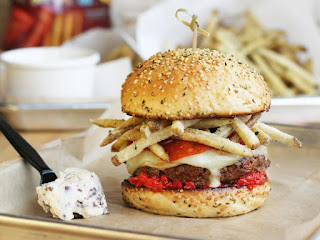When the French naturalist Nicolas Baudin first transported the swollen, underground stems of the banana plant - called corms - from Southeast Asia all the way to the Caribbean island of Martinique in the early 19th century, he kicked off a chain of events that would eventually make the banana the most cultivated fruit in the world. From Martinique, a botanist by the name of Jean François Pouyat then took clippings of the plant to nearby Jamaica in 1835. The Asian fruit was a hit in the Americas and Europe, and plantations dedicated to the banana sprung up in Honduras, Costa Rica and across Central America in the subsequent years to the extent that by the early 20th century, bananas were one of the world's top exports.
But smack dab in the middle of the century, a fungal outbreak of Fusarium oxysporum f.sp. Cubense broke out, decimating the world's banana plantations. Farmers called it Panama disease. Banana plants died en masse across plantations or rotted within the cargo holds of ships helmed by crews who incorrectly believed they had gotten their haul away in time. Importers quickly refused to even accept shipments of bananas, fearing they might bespoil otherwise sterile loading docks and markets. It took a century of human engineering for the banana to become the world's biggest selling fruit, but only a decade for it to be completely and irrevocably eliminated from commerce.
And yet, didn't you just spot an entire display full of bunches of the fruit in the produce section the other day at the grocery store? Did the barista not ask you if you wanted the banana or blueberry muffin the other morning at your corner cafe? If the banana was seriously stripped from the world, what gives?
It turns out that what we think of as a fairly homogenous fruit, ranging perhaps from green to yellow to brown, is actually one subspecies of more than 1,000. Not all bananas are even yellow. Hawaii is known for its Blue Javas, which are mightily resistant to cold temperatures and said to taste like ice cream. And much of Oceania is home to red bananas, growing wild. But one thing that the majority of banana varieties the world over have in common is the enormous seeds within the fruit. These seeds don't necessarily make every variety wholey inedible, but they certainly make consuming the fruit a labored affair.
What made the banana of Baudin, and later Pouyat, so special was its seedless interior. Instead of a yellow cartridge full of bullets, their banana - called the Gros Michel, of Fat Mike - held a starchy, creamy dream of a fruit within its peel. After the Gros Michels of the world died out, and indeed, the entire world's supply was totally decimated, there was a period ofjockeying for a replacement crop.
But sophisticated European and American consumers, having grown accustomed to the fruit, would hardly be persuaded to now pick the seeds out of the various sub-varieties that farmers attempted to push upon the unsuspecting public. The reputation of the fruit was nearly ruined for good in those initial post-Gros Michel years.
But one man stepped in with a solution to the global banana crisis. William Cavendish, the 6th Duke of Devonshire, had been cultivating a private banana collection in his Chatworth House estate's greenhouse after having received a shipment from Mauritius in 1834. These so-called Cavendish bananas originated on the Indian ocean island, and also had the distinction of being seedless. Cavendish was known to frequently ship these off as exotic gifts to far-flung friends and contacts, with bananas arriving across parts of Africa, Madagascar and, most influentially, the Canary Islands. Portuguese maritime traders encountered Cavendish bananas in the 19th century, and continued their expansion across the Southern Hemisphere, even as the Gros Michel competitor had achieved ubiquitousness at the time.
In 1888, Cavendish bananas were once more imported into England by the London-based importer Edward Fyffe. Finding the fruit to be en vogue, Fyffe and his business partners set up shop first in the Canary Islands, but then in the Caribbean as well, laying the groundwork for a global banana plantation network. Although they began selling Cavendish bananas in 1903 in global port cities, the fruit never really took off until the 1950s, when the Gros Michel market crashed. Fyffe Hudson & Co. was delighted to discover that the fungal outbreak had no effect on their burgeoning crop. Within a decade, the Cavendish banana would become the new global standard.
Cavendish bananas are the crop we see in our mind's eye when we imagine a banana today, but that was hardly the case 100 years ago. Gros Michel bananas were yellow as well, but the peels were heartier and more resistant to bruising. And the fruit within stayed fresh and more flavorful for longer periods, shipped across seas to reach ports hungry for the tropical fruit. By nearly every measure, the Gros Michel was a superior fruit, at least in terms of globalization and capitalism. But the biggest distinction between the today's Cavendish and the Gros Michel was surely the taste, with the earlier mainstay possessing a more pronounced, brighter and fuller flavor.
In fact, if you've ever wondered why artificial banana flavor - like in Runts or Laffy Taffy candies - doesn't taste quite like banana in the way that say, orange candy tastes like oranges, here's something for you to chew on. Artificial banana flavor was a replication of the Gros Michel taste, not of the Cavendish. Artificial banana flavoring draws much of its taste from the inclusion of isoamyl acetate, an organic compound found naturally in all varieties of banana, but in especially high concentrations in the Gros Michel. Cavendish bananas, on the other hand, possess a more complex chemical makeup, with larger numbers of volatile compounds that distract from the flavor of the isoamyl acetate.






























